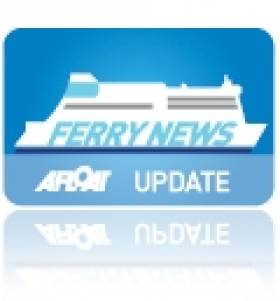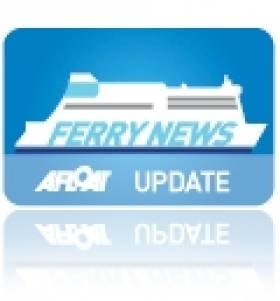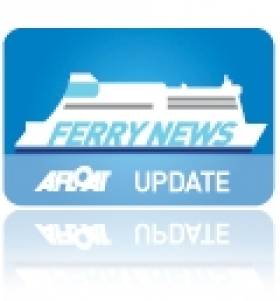Displaying items by tag: Seatruck Ferries
Seatruck Welcomes Heysham Link-Road to ‘Motorway’
#FreightFerry– Irish Sea freight-ferry operator Seatruck Ferries has welcomed the UK government's granting of the Heysham link-road to the M6 motorway, writes Jehan Ashmore.
The new road will improve both the local transport infrastructure and access to the Lancashire port, reduce congestion and cut transport costs.
Work is expected to commence this July and will near completion in late 2015.
Seatruck has been working with other local interests to push for a direct link road to junction 34 of the M6. This will enable easier port traffic access to the motorway network without having to transit through Lancaster.
The origins of Seatruck began in 1996 with the introduction of un-accompanied freight trailer service between Warrenpoint -Heysham, and to specifically meet transportation needs of the haulage industry.
Since then the company has progressed considerably with more routes: Dublin-Liverpool and Dublin-Heysham and a fleet of freight roll-on roll-off ferries.
As previously reported throughout last year on Afloat.ie, Seatruck received a quartet of custom built 'Heysham-Max' new build tonnage delivered from a Germany shipyard.
The final 18,000 tonnes 'P' class newbuild Seatruck Precision entered service last July on the Dublin-Liverpool route.
The company operate more than 50 weekly departures transiting the short-sea network of routes between Ireland and the UK.
Serving this network are freight-ferries with a capacity ranging from 65-150 unaccompanied trailer units.
Some of the 12 strong fleet, are currently deployed on the charter market to other users in the Irish Sea and operating in waters beyond this market sector.
Marine Life Researchers Get Free Passage Across Irish Sea
#MARINE WILDLIFE - Seatruck Ferries is providing free passage this autumn for surveyors with a UK-based marine wildlife charity to discover how many dolphins and seabirds make their home in the Irish Sea.
MARINElife will be extending its marine conservation research on existing sailings operating between Liverpool and Dublin - and it is hoped its surveyors will spot a variety of cetaceans en route, including minke whales, common dolphin, Harbour Porpoise and Risso's dolphins.
Grey seals, basking sharks and a host of seabirds from the gannet to the Manx Shearwater, which winters off the coast of Brazil, may also be spotted.
The charity will be running monthly scientific surveys - the first started last week on 27th September – and its recorded sightings will be posted on the MARINElife website.
It's expected that the data collected will contribute to a better understanding of the distribution and abundance of dolphins, porpoises, seals and seabirds in the Irish Sea.
The research with Seatruck Ferries also contributes to a larger project operating on ferries around the UK coastline.
Kevin Gilland, Seatruck Ferries representative involved in the project, said: "We are delighted to expand our help to MARINElife so they can further develop the understanding of the wildlife in the area. We look forward to hearing more about the wildlife encountered on these routes."
Adrian Shephard, trustee for MARINElife, commented that "ferries, or ships of opportunity as we refer to them, are a very convenient way of carrying out off-shore surveys.
"They allow us to access the same areas of ocean and monitor for changes over time - vital information which forms the basis of conservation decisions."
MARINElife research director Dr Tom Brereton described the ferry routes across the Irish Sea as "particularly vital as the area is an important passage for whale, dolphins, sharks and even turtles."
Precision Timing as Freight Newbuild Completes Quartet
#FINAL FREIGHT-FERRY – Seatruck Precision has become the final newbuild of a quartet of ro-ro freight-only ferries to enter Irish Sea service for Seatruck Ferries, writes Jehan Ashmore.
The 18,920 tonnes newbuild completed her maiden 'commercial' round-trip, departing Liverpool on Tuesday and returning overnight from Dublin with an arrival on Merseyside early yesterday morning.
She was built by Flensburger Schiffbau-Gesellschaft (FGS), Germany along with her sisters with each having a freight capacity of 2,166 lane metres spread over four decks, carrying 151 (un-accompanied) trailer units. An increase of 36 trailers compared to the quartet of older 'P' class ships.
The FGS quartet are called the 'Heyham'-max series, as they are the largest-ever vessels designed to use the tight confines of the Lancashire port. It is believed that the latest newbuild will be deployed out of the port joining Seatruck Performance, the third newbuild of the series which runs on the route to Dublin.
The remaining pair, Seatruck Power and leadship of the series Seatruck Progress operate on the Dublin-Liverpool route. However as the latter vessel is currently moored at Cammell Laird shiprepair facility in Birkenhead, the newbuild is deputising in her place on the central corridor route.
Seatruck also operate Heysham-Warrenpoint and in May a new route Heysham-Belfast began service.
Extra Freight Ferry Chartered for Manx TT Races
#MANX TT RACES FERRY NEWS – According to BBC News, an additional ro-ro freight-ferry has been chartered from Seatruck Ferries by the Isle of Man Steam Packet Company in order to cope with demand during the TT races.
More than 11,200 motorbikes are already booked to arrive in Douglas during race fortnight, which begins on Monday. The number is the highest for a decade with the exception of the event's centenary in 2007.
The chartered vessel is the Arrow (1998/7,606grt), which will assist in peak periods. The 122m long vessel can transport around 1,000 metres of freight and is the sister ship of Helliar, which covered during the island's passenger ferry Ben-my-Chree's scheduled dry dock.
Steam Packet Company Chief Executive Mark Woodward said: "While MV Arrow doesn't bring any additional passenger space, we have already made provision for 43,000 extra seats scheduled over the TT period."
"This second chartered vessel provides additional operational resilience during the busiest time of the year."
Another Fine Performance
#SEATRUCK NEWBUILD - With the announcement of Seatruck Ferries new Belfast-Heysham route to open in May, the company have in the meantime introduced a newbuild this week on the Dublin-Heysham route, writes Jehan Ashmore.
Seatruck Performance brings additional capacity to the route to Lancashire and becomes the third newbuild to enter the Irish Sea where her sisters are operating Dublin-Liverpool sailings.
She has a length of 142 m, breadth of 25 m and a capacity of 151 units, which is 35 more than the earlier 'P' Class ships which have shifted elsewhere on the Seatruck network.
The final fourth vessel Seatruck Precision as previously reported is currently under construction at the FGS Flensburg yard in Germany and is expected to make her debut on the Irish Sea in June.
- Seatruck Ferries
- Seatruck Performance
- Seatruck Precision
- Irish Sea freightferry market
- Irish Sea freight haulage market
- Irish Sea roadhaulage sector
- Ports and Shipping News
- DubliLiverpool
- DublinHeysham
- BelfastHeysham
- FGS
- FGS Flensburg
- HeyshamMax newbuilds
- Pclass Seatruck newbuilds
- Port of Heysham
- New Irish Sea freightferry
Seatruck to Launch New Freight Route
#NEW FREIGHT ROUTE – A new route between Belfast-Heysham is to be launched by Irsh Sea freight-only specialist Seatruck Ferries early next month, according to The Irish Trucker.
The new service will be opened on 7 May using the sisters Arrow and Ranger which will be switched from their current duties out of Larne.
Later in the year Seatruck will deploy larger vessels on the new Belfast route and move the service from Heysham to Liverpool, operating from the Seatruck terminal on the City side of the Mersey.
In Belfast, Seatruck will operate from Albert Quay terminal - directly opposite the Titanic Quarter. For much more on this story click HERE.
Ferry For Falmouth
#FERRY NEWS – European Endeavour (2000/ 24,046grt), the largest of three ferries running for P&O's Dublin-Liverpool route departed from the capital's port this afternoon bound for A&P Groups dry-dock facility in Falmouth, writes Jehan Ashmore.
The former Dover-Calais serving ferry started working on the Irish Sea on a full-time basis last year as previously reported. Her fleetmates are the 17,000 tonnes sisters Norbank and Norbay.
The trio of ro-pax ferries are to a design where freight is predominately the main cargo and passenger capacity is reduced considerably compared to most conventional ferries. European Endeavour can handle 130 lorries and accommodate 210 passengers whereas her fleetmates are the reverse with greater freight capacity for 150 freight units and a reduced capacity for 114 passengers.
P&O are the only ferry firm on the route providing passenger and car ferry service though they do not cater for 'foot' passengers. Their rivals Seatruck Ferries offer the only dedicated freight-operation on a network of routes on the north Irish Sea including the Liffey-Mersey link, where in recent months new tonnage has entered service.
Summer Debut for Final Seatruck Newbuild
#FERRY NEWS – The final of the quartet of new ro-ro freight vessels, Seatruck Precision was launched last week from the FSG Flensburg Yard, Germany, according to the Irish Trucker.
The compact and energy-efficient vessel, which has a capacity of up to 151 trailers was named by Mrs Lynn McBurney, wife of Seatruck customer Norman McBurney, founder of McBurney Transport - one of Ireland's largest independent haulage companies.
Seatruck Precision in June will join her three sisters on Seatruck's unaccompanied freight routes across the Irish Sea. The first newbuilding, Seatruck Progress (click HERE) operates on the Dublin-Liverpool – route. The second newbuild, Seatruck Power, joined the central corridor route in February while the third newcomer, Seatruck Performance which was launched in January, is to start operating in the Irish Sea next month.
Sister Powers On to Liverpool Route
#FREIGHT FERRY NEWS- Seatruck Power (2011/19,722grt) made her debut on the Dublin-Liverpool route last week, bringing an additional boost to freight capacity and follows her sister which only entered service in December, writes Jehan Ashmore.
The newbuild joins the leadship Seatruck Progress (see related report) on the central corridor service and another pair are due for completion by mid-year and are to be deployed on Seatruck's other Irish Sea routes.
The quartet, were all ordered from the Flensburger Schiffbau-Gesellschaft (FSG) yard in Germany. At 142m long, each of the 150-unit capacity newbuilds carry an additional 35 units compared to the 'P' class vessels, in which two of these vessels have been replaced from the Liverpool route.
Each sister has space for 2,166 lane freight metres spread across four decks, where on this particular deck hazardous and refrigerated cargo can be handled. They are also designed to carry rolling project cargo and heavy-lift items.
Another Good Performance From Seatruck
#FREIGHT FERRY - The third of four newbuilds, Seatruck Performance was launched at the FGS Flensburg Yard, Germany, last week, according to The Motorship.
The first of the newbuildings, Seatruck Progress, is now operating on the Dublin-Liverpool route. The second in the series, Seatruck Power, will join this route in mid-February (see previous report HERE). The third vessel, Seatruck Performance, will begin operations in the Irish Sea in April and the final ferry will be launched at FSG at the end of March and is due to enter service in June.
All four ships will operate mainly in the Irish Sea. They are 142m long and 25m wide, boast a freight-carrying capacity of 2,166 lane-metres on four decks and can carry up to 155 trailers.
The FSG ships are the most efficient and modern in the Seatruck fleet, and will be the biggest to operate out of the port of Heysham, the length being determined by the size of this port.
FSG engineers designed the ships for eco-friendliness and low fuel consumption. Compared to conventional ships, they are said to consume up to 30% less fuel, saving costs and representing a significant contribution to environmental protection.






































































